Men’s fashion mostly comes from Military, Sports, and Extreme Pursuits/Serious Workwear.
Think of the peacoat, trench coat, field jacket, leather bomber jacket, chinos, chukka boots, and aviator sunglasses.
Or the polo shirt, track suit, hiking boots, sneakers, baseball caps, and waxed cotton hunting jackets.
Then there’s jeans, motorcycle jackets, cowboy boots, performance fleece, and board shorts.
The point: people choose clothing based on associative identity:
- What will others associate with this piece of clothing?
- What does wearing this say about me?
And men want to be associated with virile masculinity.
Of course, clothing has to be functional as well. This separates fads from classics and is why no one’s worn parachute pants in 40-odd years.
Fortunately, military, sports, and work clothing tend to be inherently practical to begin with.
And that’s where our two boots come into play. The boots?
- Timberland’s iconic Yellow Work Boot, and
- Dr. Martens’ equally iconic Air-Walk 1460.
Both began as innovative workwear with a distinctive, instantly recognizable feature.
Both companies poured money into advertising and positioning in order to broaden their appeal.
And both boots were adopted as an unofficial uniform by the music industry and rebellious teens, eventually transforming both companies into billion-dollar brands.
Let’s look at Timberland first.
How a Design Limitation Became a Design Icon
There were waterproof boots before Timberland, but they weren’t leather. They were Wellingtons or L.L. Bean boots that used rubber to keep the water out.
Fortunately, Herman and Sidney Swartz — 2nd-generation owners of Timberland — knew leather waterproof boots could be made via then-new tech.
Back in 1973, they used silicone-tanned nubuck leather connected to injection-molded soles to make truly waterproof leather work boots.
Add newly developed PrimaLoft insulation, and you have an ideal, revolutionary all-season, waterproof boot for construction workers.
According to Sidney, their design process was simple:
“Let’s build the finest product we can possibly build and worry about the pricing afterward.”
 So they did. But there was a catch….
So they did. But there was a catch….
The only silicone-tanned, waterproof, scuff-resistant nubuck they could find in the quality they needed came in just one color — the distinctive yellow the company calls “wheat”
And how fortunate they were with that “limitation.”
The distinctive yellow and embossed logo on the heel made Timberlands instantly recognizable.
While their superior, water-proof performance meant blue-collar workers loved them. They quickly dominated that market.
But instead of being content with that, Timberland stepped on the gas with aggressive advertising throughout the 80s and 90s, focused on broadening their appeal to a more aspirational market.
Key aspects of the campaign included:
- Upscale Magazine Placement. Their print ads ran in high-end magazines like The New Yorker and Gentleman’s Quarterly, which elevated the brand’s image among a more affluent demographic.
- Message Focus on Quality and Durability with long copy that emphasized their superior craftsmanship, waterproof performance, and durability.
- Upscale Retail Presence. The boots were sold in luxury department stores such as Saks Fifth Avenue and Bergdorf Goodman, reinforcing the perception of the brand as a status symbol
- Lifestyle Appeal. The ads gradually shifted from a focus on work boots to include boat shoes, hiking boots, and outdoor apparel.
- Brilliant Print Advertising: Classic long-copy print ads with “sucker punch headlines” and riveting copy that detailed the brand’s superior quality.
Here are a few examples:

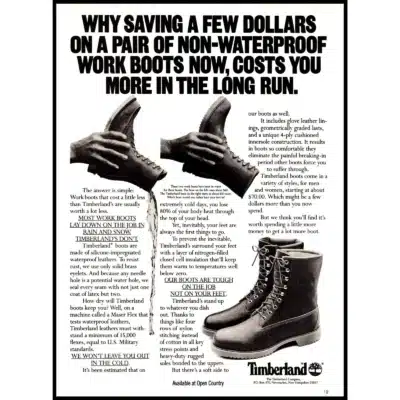
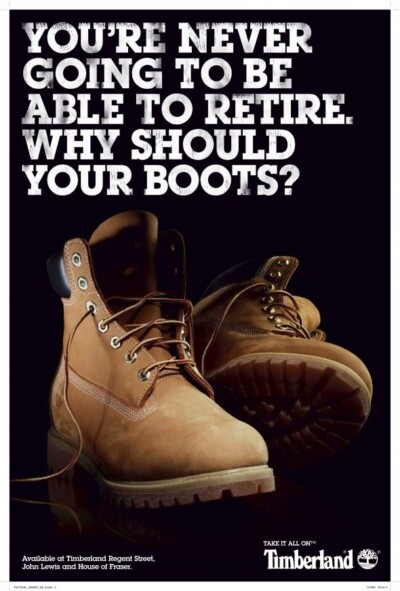

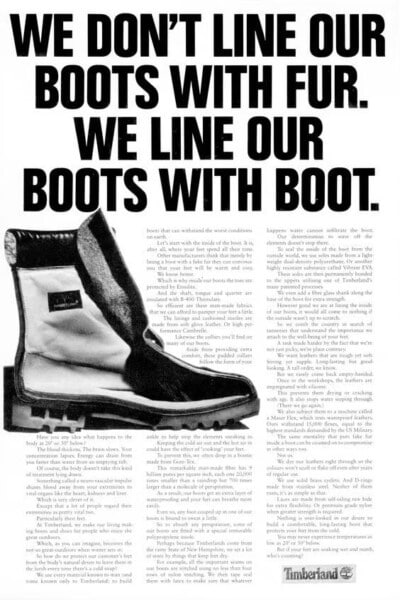
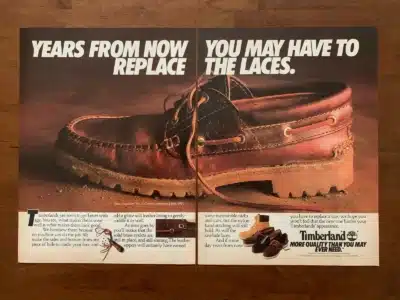

The advertising worked and transformed Timberland into a highly desired aspirational brand.
Their iconic look, comfort, and ready-for-anything appeal made them a must-have status symbol among rappers, hip-hop celebrities, and inner city youth.
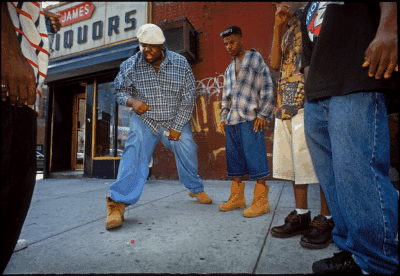 Timberland boots actually outsold Air Jordan sneakers during the mid-80s, and were celebrated by name in lyrics from:
Timberland boots actually outsold Air Jordan sneakers during the mid-80s, and were celebrated by name in lyrics from:
-
- Notorious BIG,
- Jay-Z,
- DMX
- Wu-Tang Clan, and
- Das EFX.
If you were cool, you had to have a pair of “Timbs,” and if you did, everyone knew thanks to the distinctive color and embossed logo.
Sales shot up, going from a reported $13 million in 1982 to over $1 billion in 2000.
Performative Quality Becomes a Brand Icon
In 1945, Dr. Klaus Maertens created a unique air-cushioned, shock-absorbing rubber sole (vs. traditional hard leather soles in most footwear) to help him recover from a broken foot.
He then teamed up with a mechanical engineer to put the new sole into production, and by 1959, their company entered into a licensing agreement with the Griggs family in the UK.
 The Griggs family, who ran a well-known boot company with a solid reputation, used Dr. Maertens innovative soles to create the first pair of 1460 Dr. Martens boots.
The Griggs family, who ran a well-known boot company with a solid reputation, used Dr. Maertens innovative soles to create the first pair of 1460 Dr. Martens boots.
But unlike Timberland’s unmistakable yellow nubuck leather, Dr. Martens distinctive yellow stitching was chosen on purpose.
It was purposefully used to draw attention to the construction quality and repairability of the boot while making them stand out as a unique, innovative product.
The yellow thread is used to stitch the welt around the upper before the PVC “Bouncing Soles” is melted on with extreme high heat. This welt system sets the shoes apart, guaranteeing toughness, repairability, and longevity.
Initially, the boots were a hit with working-class Brits, who loved the iron durability and sneaker-like comfort. But then something extraordinary happened.
Dr. Martens were picked up by early multi-cultural, anti-establishment punk and ska musicians, who proudly championed British working-class style.
Then Pete Townshend of The Who wore them as a symbol of his own working-class pride, changing this functional work boot into a subcultural badge of rebellion.
Shortly after that, Dr. Martens leaned into these associations with their advertising.
By the time the 80s and 90s rolled around, it wasn’t just punk, ska, and grunge musicians, but too-cool-for-school teenagers, movie stars, and even runway models.
And just like Timberland, Dr. Martens became immortalized in song lyrics:
“It’s not class or ideology / color, creed, or roots /
the only thing that unites us / is Doctor Martens boots / hey.”
– Alexei Sayle in “The Young Ones,” 1982
Check out this 1980s TV ad from the company, leaning hard into this expanded market:
And here are print ads from the same time frame:






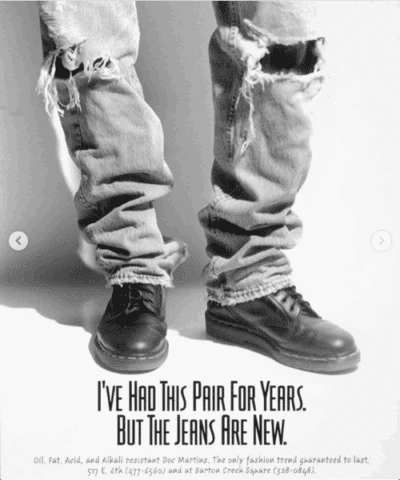
Sales went from around $50 million in 1980 to $412 million by 1999.
The company has had its share of ups and downs from 2000 to now, but the brand was strong enough to garner a $5 billion valuation in its 2021 IPO.
Boot-Kicking Branding Lessons
1. Distinctiveness Matters.
Quality is great, but people need to see the difference at a glance. The yellow color of Timberlands didn’t make the boots any better, but it did make them stand out.
The yellow stitching of Dr Martens didn’t improve the Goodyear Welt construction, but it did make the boots unmistakably recognizable at a distance.
 We’re social creatures. If we’re going to invest in a status symbol, we want it recognized by others.
We’re social creatures. If we’re going to invest in a status symbol, we want it recognized by others.
And it ain’t just for fashion. Apple used to to great success with their distinctive white earbuds, and even service companies have managed to pull it off.
2. Branding Is Association Design
Men want to associate themselves with virile masculinity.
So when Timberlands and Dr Martens became the go-to footwear for hard-working men, it was those associations that fueled their growth as a pop-culture status symbol.
And it was because the brands were smart enough to lean into those associations that their advertising proved so effective.
Mix authentic, attractive associations with mass media advertising that leverages those associations, and you get explosive growth. Simple as that.
3. Advertising and Positioning Are Crucial
Neither company would have grown had its appeal been limited to blue-collar workers.
And while their initial appeal beyond that niche was organic, neither company would have become a truly iconic product without aggressive advertising that branded and positioned them to a broader market.
Exponential growth is never accidental. You can’t grow into a big dog without barking like one first.
4. USPs Never Last — Bonding & Distinctiveness Are Must-Haves.
It wasn’t long before other companies created waterproof leather work boots, or leather boots with comfy rubber soles.
Heck, other companies even tried to copy the look of Timberland and Doc Martens.
And if that’s all the brands had going for them, they’d have faded away.
Instead, both brands created strong bonds within their markets and had distinctive brand features — both developed before imitation was possible — that made them impervious to cut-rate competitors.
So… what’s Distinctive about your brand?
And how is your advertising positioning you with — and bonding you to — your customer base?
Answer that and you’ll be sure to enjoy boot-kicking success.
Need help? Contact me for a free conversation and brand review.
- Unmistakable: A Tale of Two Boots and Branding Done Right - November 8, 2025
- Making the Branding Math *Math* with Broadcast Radio - October 30, 2025
- Identity-Based Branding - October 21, 2025

